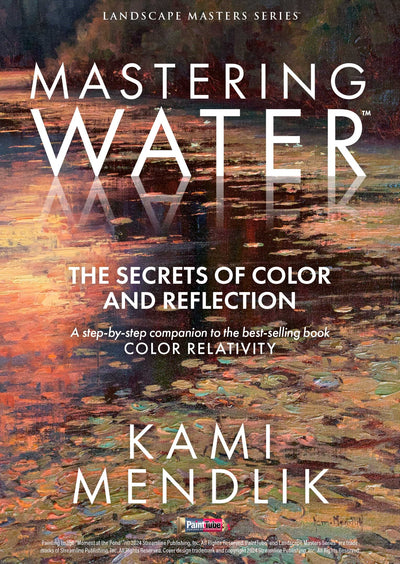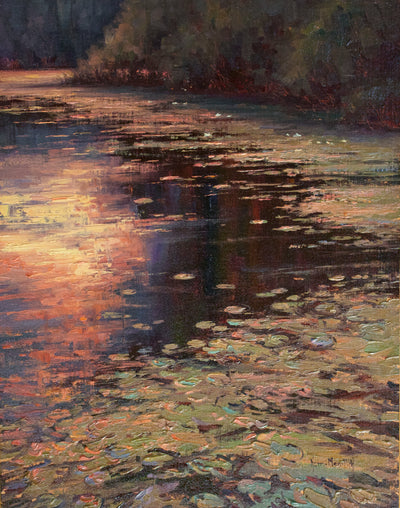Your Cart is Empty
FREE U.S. DOMESTIC SHIPPING • 100% MONEY-BACK GUARANTEE • Lifetime Access • No Subscription






$147.97 
Painting realistic water and reflections convincingly is tricky.
The magical key lies in understanding how colors interact with each other and understanding the principles of light and reflection.
If you’re always trying to guess the color, then here’s a fool-proof way to get it right every single time!
Inside this video, renowned master artist and instructor Kami Mendlik shares her secrets to mastering color so you can create ANY color, at ANY time, WITHOUT guessing.
Through understanding color, you’ll learn to replicate the subtle nuances of light and shadow, the distortion of images in water, and the vibrancy of life reflected on its surface.
With Kami Mendlik’s ingenious game-changing approach, you’ll learn how to interpret the complex color interactions you see in water scenes.
One pivotal lesson that will help you paint water scenes with depth accurately is viewing water and reflections as a shape and color.
In other words, you’re going to learn a NEW way to see water scenes - which could be the breakthrough you’ve been looking for.
Though mastering water scenes takes more than just a few hours…
…the lessons you’ll learn will equip you with a solid foundation and the right techniques for successful, realistic results!
You’ll learn how to solve challenges like how to know what to put in and what to leave out, how to make sure your water lays flat, how to create reflections with depth, how to make water look “wet,” and so much more.
On top of that, you’ll learn to craft the “illusion of light” - where you’ll train your eyes to see through the illusion and see what really goes on behind the scenes.
Kami has been teaching her approach to nearly 1000 students over the past 20 years.
Kami understands the struggles artists go through…
…which means she knows how to get to the crux of the issue and show you WHAT WORKS.
Her emphasis on teaching the properties of color and how colors relate to one another in an approachable, understandable way has been a game changer for both new and experienced painters.
If your goal is to paint water and reflections convincingly, this video could be what you’re looking for!
While it’s true that mastery takes more than a few hours…
…the lessons you’ll learn will equip you with a solid foundation and the right techniques for successful, realistic results!
Time to solve this challenging puzzle once and for all so you start painting more water scenes confidently!
Introduction (3 min.)
Kami Mendlik introduces the video by talking about her plein air painting experiences. She explains how these outdoor sessions can lead to complete artworks or serve as references for larger studio projects. Using your own outdoor experiences and observations can help you understand realistic reflections in water more intimately.,Kami’s aim for this video course is to blend experiences and creativity with traditional art principles.
Graphing Your Subject (8 min.)

Hate math? No problem. In this chapter, Kami outlines a straightforward method for enlarging a plein air study to a studio painting without using math! She uses a photograph of her outdoor color study, explaining how to create a grid on both the photo and painting surface. This technique helps maintain accurate proportions as she begins painting.
Materials (5 min.)
Kami reviews the oil painting materials she uses, including her choice of paints (she paints with an expanded limited palette), brushes, and palette knives, as well as her preference for a halftone gray palette. This choice is crucial for accurately seeing the value of colors, a topic she will explore in depth throughout the demonstration.
The Block-In Wash (30 min.)

This chapter focuses on beginning the painting by establishing the dark areas first. Kami stresses the importance of working with transparent colors to lay down the foundational shapes and tones, preparing for the application of thicker layers of paint later on. She discusses the role of brushwork in creating reflections and the overall composition, emphasizing big shapes and accuracy from the start.
Build Up Shapes (49 min.)
Kami continues to develop the painting by adding to the initial shapes, now adding white to create opaque and lighter colors. She advises on constantly evaluating the temperature and value of colors as the painting progresses. The chapter emphasizes the non-final nature of this stage, encouraging flexibility and adjustment to get the colors just right.
Create Color Harmony (46 min.)

This chapter delves into techniques for achieving color harmony and guiding the viewer's eye through the painting. You’ll learn how to use “transition colors” to help separate subjects softly to lead the viewer’s eye through the painting. You’ll also learn how Kami vividly recalls and incorporates all senses experienced during her plein air session into the studio work. Tips on maintaining connected dark and light shapes, being fully present in the painting process, and achieving “wet-looking” water surfaces are highlighted, along with practical advice on using a palette knife for lily pads.
Work on Nuances (25 min.)
Kami focuses on the finer details of the painting, particularly the lily pads. She emphasizes the importance of preparing mixes of the "average color" beforehand to streamline the painting process. This chapter is about appreciating and applying the subtle nuances of color that contribute to a cohesive yet dynamic composition.
Build Up the Lights (48 min.)

Here, Kami moves on to enhancing the light reflections in the painting, inspired by a striking visual memory of sunlit clouds reflecting on a pond. You’ll discover tips for keeping colors clean and vibrant, how to paint like you're using warm, whipped butter, and brush techniques for creating atmospheric effects in the background.
Refine (47 min.)
In the refinement stage, Kami adds ripples and further develops the atmospheric effects. She reiterates her favorite paint consistency and provides a guide on painting lily pad flowers, emphasizing the natural variation in color. This chapter covers the importance of restraint in making changes, the technique for adding sparkle to water, and maintaining realistic reflections throughout the painting.
Take It to Finish (19 min.)

Kami discusses the criteria for assessing the completion of the painting, including color harmony, the movement of the viewer's eye, and the overall balance of elements within the composition. This chapter teaches you how to know when a painting is finished, focusing on harmony and the effectiveness of reflections and color notes.
Final Review (6 min.)
In the final chapter, Kami reviews the painting, summarizing key learnings from the video. This wrap-up reinforces the concepts and techniques covered throughout the tutorial, ensuring you’re fully equipped to apply these insights to your own work with water scenes!
PLUS:
That’s it!
When you reach this point, you'll feel equipped and confident to masterfully tackle water scenes.
Get started today!

What do these masters have in common?
Could you believe they were all Kami Mendlik’s teachers?
All that training under such brilliant painters molded Kami to who she is today - one of the best painters in the world today.
Her knowledge in creating wonderful works of art plus her incredible teaching ability makes her a highly-sought after instructor!
Founder of the St. Croix River School of Painting, she's renowned for teaching representational painting with a focus on color.
Her dedication has earned her the Dorothy Driehaus Mellin Fellowship in 2022 and a Bronze Medal at the Oil Painters of America National Juried Exhibition the same year.
Her book Color Relativity: Creating An Illusion Of Light With Paint, is a testament to her expertise and passion for teaching the nuances of color to create light and vibrancy in paintings.
As a distinguished alumni recipient from Stillwater Area High School, Kami is a signature member of American Women Artists and the American Impressionist Society, demonstrating her respected status in the art community.
Now’s your chance to study under this amazing artist and see YOUR artistry soar to even greater heights!





